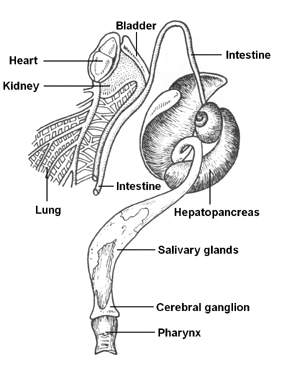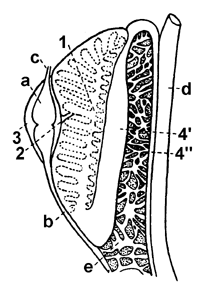
Digestion organs of a Roman snail.
Source: Kilias (1985).
 Digestion organs of a Roman snail. Source: Kilias (1985). |
After a snail has taken in its food, rasping it into tiny little bits with its radula, the food disappears in the snail's gullet to be digested.
The first steps of digestion already take place in the snail's mouth. Here the saliva, produced by the two large salivary glands both sides of the crop, digest carbohydrates, such as starch and sugar. Proteins and celluloses, though, are not digested by the salivary enzymes. The saliva also change the food into pulp that can easier be transported into the gullet.
At its rear and the stomach or crop is a blind sack, in which the food pulp is dammed. Here the main part of digestion takes place. The digestive fluids are produced by the main digestive gland or hepatopancreas.
Contrary to the saliva, the digestive fluids from the hepatopancreas can digest not only carbohydrates, but also proteins and lipids. The Roman snail is so provided with an array of enzymes, which also can digest substances indigestible for humans. With help of symbiotic bacteria it can even digest cellulose, in fact it would even be capable of that on its own, only with lesser efficiency.
From the stomach blind sack, the digestive tract is continued by the intestine. It begins with a ciliated groove in the stomach, through which indigestible parts of food are transported towards the exit. There is a final resorption of simple sugar molecules in the intestine as well. The snail's intestine finally opens outside by the anus, which is located near the respiratory opening in the apertural mantle fold. The dark thread of faeces can often be seen, when a crawling snail simply leaves it behind.
The main digestive gland of hepatopancreas, is the largest gland in the Roman snail's organism. A large, dark brown organ, it makes the largest part of the visceral sac inside the shell. Though the organ is often referred to as "liver" in books, the term "hepatopancreas" or even "main digestive gland" is much more accurate, as the simple term "liver" does not do justice to the many functions of this gland.
|
The Functions of the Main Digestive Gland: The main digestive gland has so many functions, that the term "liver", often found, does not suffice: |
Other than the human liver the snail's main digestive gland not only produces digestive fluids and stores nutrients. It also performs digestion as such and resorption, which means it extracts nutrients from the digested food. Digestion changes the food pulp into a diluted juice rich in nutrients, that flows from the stomach into the lobes (follicles) of the digestive gland. Enzyme cells there produce digestive fluids, whereas liver cells extract nutrients from the food juice.
Another function of the main digestive gland is performed by a further cell type. In lime cells dissolved calcium carbonate is extracted from the food and stored. From here it is later transported dissolved in the blood fluid into part of the organism in need of lime. Besides the genital apparatus, in need lime to make egg shells, those are mainly the shell building cells in the mantle. Also the hibernation lid is made from lime, as is, from a small amount of it, the love dart.
 A Roman snail's kidney. Source: Kilias (1982). |
In digestion harmful side-products may form, whose accumulation in the organism might lead to symptoms of poisoning. Their excretion is performed in the kidney, an organ located in the immediate vicinity of the snail's heart (see: Respiration and Circulation).
Illustration on the left: A Roman snail's kidney. 1: Kidney cavity with schematic view of septs full of blood. 2: Ciliate funnel (renopericardial duct). 3: Heart bag (pericardium). 4' Primary and 4'' secondary ureter. a: Ventricle. b: Pulmonary vein. c: Aorta. d: Intestine. e: Lung. Source: Kilias, 1982.
The Roman snail's kidney basically is a nephridium, the less far developed forms of which still can be found among more archaic water snails, but especially among segmented worms, such as the earthworm.
The blood is filtered into the pericardium, the heart bag surrounding the heart. So there the primary urine forms, containing, aside from harmful waste substances, also nutrients, such as small sugar molecules. By a ciliate funnel this primary urine flows into the renopericardial duct leading from the pericardium into the kidney. There all utilisable nutrients are extracted from the primary urine, as far as possible. The inner surface of the kidney bag therefore is divided into septs (1) which largely increase the surface area. Inside the septs blood fluid circulates, to transport the extracted nutrients away. The secondary urine, on the other hand, is excreted past the ureter (4) into the pallial cavity.
Basically a terrestrial snail's excretion follows the same principle. But, like the respiration, is has largely adapted to terrestrial life. The blood is filtered at the septs' walls. While water snails excrete ammonia, terrestrial snails' excretion produces uric acid, that crystallises on the septs' walls to form whitish crystals.
This way the Roman snail only loses a minimal amount of water to dissolve the uric acid, which is finally excreted as a light brownish paste.